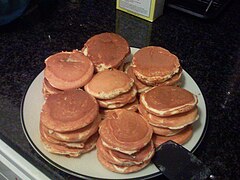
Pancake
A pancake (or hotcake, griddlecake, or flapjack) is a flat cake, often thin and round, prepared from a starch-based batter that may contain eggs, milk and butter, and then cooked on a hot surface such as a griddle or frying pan. It is a type of batter bread. Archaeological evidence suggests that pancakes were probably eaten in prehistoric societies.[1]
This article is about the food. For other uses, see Pancake (disambiguation). "Griddle cake" redirects here. For the Irish-style bread, see Soda bread. "Banana pancakes" redirects here. For the Jack Johnson song, see In Between Dreams. "Hotcakes" redirects here. For the album by the Darkness, see Hot Cakes. For the album by Carly Simon, see Hotcakes (album).Type
The pancake's shape and structure varies worldwide. In the United Kingdom, pancakes are often unleavened and resemble a crêpe.[2] In North America, a leavening agent is used (typically baking powder) creating a thick fluffy pancake. A crêpe is a thin pancake of Breton origin cooked on one or both sides in a special pan or crepe maker to achieve a lacelike network of fine bubbles. A well-known variation originating from southeast Europe is palatschinke, a thin moist pancake fried on both sides and filled with jam, cream cheese, chocolate, or ground walnuts, but many other fillings—sweet or savoury—can also be used.
Commercially prepared pancake mixes are available in some countries. Like waffles, commercially prepared frozen pancakes are available from companies like Eggo. When buttermilk is used in place of or in addition to milk, the pancake develops a tart flavor and becomes known as a buttermilk pancake, which is common in Scotland, Ireland and the US. Buckwheat flour can be used in a pancake batter, making for a type of buckwheat pancake, a category that includes blini, kaletez, ploye, and memil-buchimgae. When potato is used as a major portion of the batter, the result is a potato pancake.
Pancakes may be served at any time of the day or year with a variety of toppings or fillings, but they have developed associations with particular times and toppings in different regions. In North America, they are typically considered a breakfast food and serve a similar function to waffles. In Britain and the Commonwealth, they are associated with Shrove Tuesday, commonly known as "Pancake Day", when, historically, perishable ingredients had to be used up before the fasting period of Lent.
History
The Ancient Greeks made pancakes called τηγανίτης (tēganitēs), ταγηνίτης (tagēnitēs)[3] or ταγηνίας (tagēnias),[4] all words deriving from τάγηνον (tagēnon), "frying pan".[5] The earliest attested references to tagenias are in the works of the 5th-century BC poets Cratinus[6] and Magnes.[7] Tagenites were made with wheat flour, olive oil, honey, and curdled milk, and were served for breakfast.[8][9][10] Another kind of pancake was σταιτίτης (staititēs), from σταίτινος (staitinos), "of flour or dough of spelt",[11] derived from σταῖς (stais), "flour of spelt".[12] Athenaeus mentions, in his Deipnosophistae, staititas topped with honey, sesame, and cheese.[13][14][15] The Middle English word pancake appears in English in the 15th century.[16][17]
The Ancient Romans called their fried concoctions alia dulcia, Latin for "other sweets". These were much different from what are known as pancakes today.[18]
Syndrome
Pancake syndrome is an allergic reaction which some people have after eating pancakes in tropical regions where certain mites can contaminate the flour in pancakes.[60]













